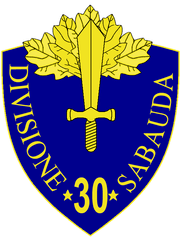30th Infantry Division Sabauda
| 30th Infantry Division Sabauda | |
|---|---|
 30th Infantry Division Sabauda Insignia | |
| Active | 1939–1943 |
| Branch |
Royal Italian Army |
| Type | Infantry |
| Size | Division |
| Nickname(s) | Sabauda |
| Engagements | World War II |
The 30th Infantry Division Sabauda was an infantry division of the Royal Italian Army (Regio Esercito) during World War II.
History
Second Italo-Ethiopian War
The territorial division Cagliari was mobilized 1 October 1934, renamed Sabauda (30a) after a newly built town of Sabaudia and sent to Eritrea, arriving in Massawa 21 June 1935. During its absence on Sardinia until 9 February 1937, it was replaced in Sassari and Cagliari by Sassari II infantry division (130a) and Sassari II infantry brigade (130).[1] Initially the Sabauda division was tasked with the defence of the Asmara-Dek’emhāre area. At the beginning of the war 3 October 1935, it held a defensive line near Barachit. After overcoming initial Ethiopian resistance at Fik’ada (Focada) it advanced rapidly, but nearly came to a stop on 7 October 1935. In November 1935, it seized the Negash, Agula and Bolbala towns. It held positions on heights overlooking Tekezé River during the Ethiopian Christmas Offensive. The division started to advance on 6 January 1936, but remained in Enderta Province during February 1936. The Sabauda division had a minor fight at Battle of Amba Aradam 13–27 February 1936. By 3 April 1936, the division arrived at Amba Alagi, where it won a decisive encounter and pursued the retreating Ethiopians to Agumserta and finally to Lake Ashenge. With way to Addis Ababa open, the division surged forward, reaching Shewa Kifle Hāger village on the capital's outskirts 26 April 1936, and captured Addis Ababa itself on 5 May 1936. The division remained in the capital area until December 1936, when it was recalled to Italy.
Second World War
30th Division Sabauda was reorganized as a binary division 15 April 1939. It originally deployed between Cagliari and Iglesias, Sardinia, with headquarters in Cagliari. In June 1940, divisional positions were reduced to the area around Sulcis. The Sabauda division stayed there until Armistice of Cassibile was announced 8 September 1943. 10 September 1943 it repositioned to repel German forces at Villacidro-Samassi-Selegas-Suelli, facing north. After Wehrmacht forces evacuated to Corsica, the division was ordered to Sicily on 10 November 1943. It initially arrived in Enna-Caltanissetta region and until relocated to Messina-Catania-Syracuse area in September, 1944. On 1 October 1944, the division was relegated to security division status and performed various duties ranging from airfield and coastal defence to demining.
Order of Battle Oct. 1935
30th Division "Sabauda" - Gen. Italo Gariboldi
- 3rd Bersaglieri Regiment
- 46th Infantry Regiment "Reggio"
- 60th Infantry Regiment "Calabria"
- 16th Artillery Regiment
- 530th MMG Bn
- 30th Replacements Bn
- 30th Engineers Coy
Notes:
- Each Army Division in the Ethiopian Campaign had a Pack-Mules unit of 3000 mules and three Regimental Trucks units (20 light trucks each).
- 3rd Bersaglieri Regiment was detached during the campaign to form the core of the Celere Column A.O..
Order of Battle June 1940
30th Division "Sabauda"
- 45th Infantry Regiment
- 46th Infantry Regiment
- 30th Mortar Battalion
- 30th Antitank Company
- 16th Artillery Regiment
- 30th Engineer Battalion
- 30th Medical Services
- 30th Supply Services[nb 1]
Notes
- Footnotes
- ↑ An Italian Infantry Division normally consisted of two Infantry Regiments (three Battalions each), an Artillery Regiment, a Mortar Battalion (two companies), an Anti Tank Company, a Blackshirt Legion (Regiment of two Battalions). Each Division had only about 7,000 men, The Infantry and Artillery Regiments contained 1,650 men, the Blackshirt Legion 1,200, each company 150 men.[2]
- Citations
- ↑ http://www.regioesercito.it/reparti/fanteria/rediv30.htm
- ↑ Paoletti, p 170
- Paoletti, Ciro (2008). A Military History of Italy. Greenwood Publishing Group. ISBN 0-275-98505-9.
External links